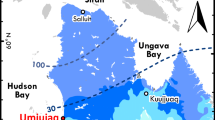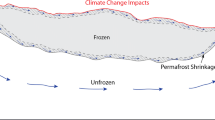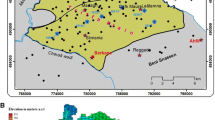Abstract
The impact of glaciation cycles on groundwater flow was studied within the framework of nuclear waste storage in underground geological formations. The eastern section of the Paris Basin (a layered aquifer with impervious/pervious alternations) in France was considered for the last 120 ka. Cold periods corresponded with arid climates. The issue of talik development below water bodies was addressed. These unfrozen zones can maintain open pathways for aquifer recharge. Transient thermal evolution was simulated on a small-scale generic unit of the landscape including a “river” and “plain”. Coupled thermo-hydraulic modeling and simplified conductive heat transfer were considered for a broad range of scenarios. The results showed that when considering the current limited river dimensions and purely conductive heat transfer, taliks are expected to close within a few centuries. However, including coupled advection for flows from the river to the plain (probably pertinent for the eastern Paris Basin aquifer recharge zones) strongly delays talik closure (millennium scale). The impact on regional underground flows is expected to vary from a complete stop of recharge to a reduced recharge, corresponding to the talik zones. Consequences for future modeling approaches of the Paris Basin are discussed.
Résumé
L’impact des cycles glaciaires sur l’écoulement d’eau souterraine a été étudié dans le cadre d’un stockage souterrain de déchets radioactifs dans les formations géologiques du sous-sol. On a considéré la partie Est du Bassin Parisien (un aquifère multicouches avec alternance de formations imperméables/perméables) en France, au cours des derniers 120 000 ans. Les périodes froides correspondent à des climats arides. La question du développement de taliks sous les cours d’eau a été traitée. Ces zones non gelées peuvent maintenir des passages ouverts pour la recharge des aquifères. Une évolution thermique transitoire a été simulée sur une unité typique du paysage à petite échelle comprenant une « rivière » et une « plaine ». La modélisation couplée thermo-hydrodynamique et de simples transferts de chaleur par conduction ont été considérés pour une large gamme de scénarios. Les résultats montrent que, lorsque l’on considère les dimensions actuelles limitées de la rivière et des transferts de chaleur purement conductifs, les taliks sont supposés se fermer en quelques siècles. Cependant, la prise en compte de flux advectifs couplés de la rivière vers la plaine (ce qui est probablement pertinent pour les zones de recharge des aquifères de l’Est du Bassin Parisien) retarde fortement la fermeture des taliks (échelle millénaire). L’impact sur les écoulements souterrains régionaux est supposé varier entre un arrêt complet de la recharge et une recharge réduite, correspondant aux zones de taliks. Les conséquences pour les futures approches de modélisation du Bassin Parisien sont discutées.
Resumen
Se estudió el impacto de los ciclos de glaciación sobre el flujo de agua subterránea dentro del marco del almacenamiento de residuos nucleares en formaciones geológicas en el subsuelo. Se consideró los últimos 120 ka para la sección oriental de la cuenca de París en Francia (un acuífero estratificado con alternancia de capas permeables e impermeables). Los períodos fríos se corresponden con climas áridos. Se trató la cuestión del desarrollo del talik debajo de los cuerpos de agua. Estas zonas no congeladas pueden mantener trayectorias abiertas para la recarga del acuífero. Se simuló la evolución termal transitoria sobre una unidad genérica de pequeña escala del paisaje incluyendo un “rio” y una “planicie”. Se consideraron modelados acoplados térmicos e hidráulicos y de transferencia conductiva de calor simplificados para un amplio rango de escenarios. Los resultados muestran que cuando se consideran los actuales ríos de dimensiones limitadas y puramente de transferencia conductiva del calor, se espera que los taliks se cierren dentro de unos pocos siglos. Sin embargo, incluyendo la advección acoplada para flujos del río a la planicie (probablemente pertinente para el este de la zona de recarga del acuífero de la cuenca de París) se retrasa fuertemente el cierre de los taliks (a escala de milenios). El impacto sobre el flujo subterráneo regional se espera que varíe desde un cese completo de la recarga a una recarga reducida, correspondiente a la zona de taliks. Se discuten las consecuencias de futuros enfoques de modelados de la cuenca de París.
摘要
本文在地下的地质构造中储存核废物的框架中研究了冰期旋回对地下水流的影响。本文讨论了法国巴黎盆地的东部地区(一个具有不透水/透水交替变化的层状含水层)最近12万年的变化。冰期与干旱的气候相一致。文中提出了在水体之下不冻区的发育问题。这些不冻区可以为含水层的补给维持开放的路径。文中模拟了小尺度地形通用单元中短暂的热演化,包括“河流”和“平原”。本文讨论了可应用于更多实例的相互耦合的热工水力模型和简化的热传导。结果显示,当考虑现有的有限的河流维度和纯粹的热传导时,不冻区可能在几个世纪内闭合。然而,包括从河流到平原(可能与巴黎盆地东部的含水层补给区相关)的水流的耦合对流强烈地延迟了不冻区的闭合(千年的尺度)。这对区域地下水流很有可能造成从补给完全消失变化到补给减少等不同程度的影响,与不冻区相一致。文中最后讨论了巴黎盆地未来的模拟方法的结果。
Resumo
O impacte dos ciclos de glaciação no fluxo de água subterrânea foi estudado dentro de um quadro de armazenamento de resíduos nucleares enterrados em formações geológicas. A secção este da Bacia de Paris (um aquífero multicamada com alternâncias impermeável/permeável), em França, foi considerada para os últimos 120 ka de períodos frios correspondentes a climas áridos. Foi abordada a questão do desenvolvimento de taliks (volume de solo não congelado dentro do permafrost) sob camadas aquíferas. Estas zonas não congeladas podem manter canais abertos para a recarga de aquíferos. Foram simuladas evoluções termais transientes numa unidade genérica de paisagem, a pequena escala, incluindo um “rio” e uma “planície”. Foi considerado um modelo termo-hidráulico acoplado e uma transferência de calor condutivo simplificado, para uma larga variedade de cenários.
Os resultados mostram que, quando considerando as dimensões correntes limitadas do rio e uma transferência de calor puramente condutiva, é expectável que os taliks fechem dentro de uns poucos de séculos. No entanto, ao incluir adveção acoplada para fluxos do rio para a planície (provavelmente pertinente para as zonas de recarga do aquífero da Bacia oriental de Paris), surge um forte atraso no fecho dos taliks (à escala de milénios). É expectável que o impacte nos fluxos de água subterrânea regional variem desde a completa paragem na recarga até uma redução na mesma, correspondente às zonas de talik. São discutidas as consequências para as futuras abordagens à modelação na Bacia de Paris.
Abstrakt
Effekterna av glaciala cykler på grundvattenflödet har studerats inom ramen för lagring av kärnavfall i underjordiska geologiska formationer. Studien avser den östra delen av Paris Bassängen i Frankrike (en lagrad akvifär med ogenomträngliga / genomsläppliga strukturer), den studerade tidsperioden representerar de senaste 120 ka. Kalla perioder motsvarar torra klimat. Frågeställningar kring utveckling av Taliker under vattendrag har inkluderats i studien. Sådana ofrysta områden kan upprätthålla öppna flödesvägar för grundvattenbildning till underliggande akvifärer. Den tidsberoende temperaturutvecklingen simulerades med hjälp av småskaliga generiska landskapsenheter av typen “flod” eller “slätt”. Studien är en kopplad termo-hydraulisk modellering med en förenklad beskrivning av konduktiv värmeöverföring. Ett brett spektrum av scenarier har inkluderats. Resultaten visar att när man simulerar de begränsade floddimensioner som förekommer för närvarande och endast inkluderar konduktiv värmetransport, kan taliker förväntas var stängda (frysta) inom några århundraden. Om också advektion inkluderas i den kopplade termo-hydrauliska beskrivningen för flöden från floder till slätt (vilket troligen är en relevant process för östra Paris Bassängens inströmningsområden) kommer stängningen av taliker att starkt fördröjas (millennium skala). Påverkan på de regionala underjordiska flödena förväntas variera från ett fullständigt förhindrande av grundvattenbildning till en förminskad grundvattenbildning som endast förekommer vid taliker. Vilka konsekvenser studiens resultat har för framtida metoder att modellera Paris Bassängen diskuteras.













Similar content being viewed by others
References
Aguirre-Puente J, Costard F, Posado-Cano R (1994) Contribution to the study of thermal erosion on Mars. J Geophys Res 99(E3):5657–5667
ANDRA (2005) Dossier 2005 - Recherches de l’ANDRA sur le stockage géologique des déchets radioactifs à haute activité et à vie longue [ANDRA Research concerning geological storage of high activity and long life radwastes. ANDRA report, ANDRA, Châtenay-Malabry, France
Antoine P, Marchiol A, Brocandelle M et al (2005) Découverte de structures périglaciaires (sand wedges et composite-wedges) sur le site de stockage de déchets radioactifs de Soulaines (Aube-France) [Discovery of periglacial structures (sand wedges and composite wedges) on the Soulaines radioactive waste storage site (Aube, France)]. CR Acad Sci II 16:1462–1473
Bense VF, Ferguson G, Kooi H (2009) Evolution of shallow groundwater flow systems in areas of degrading permafrost. Geophys Res Lett 36:L22401
Beyerle U, Purtschert R, Aeschbach-Hertig W, Imboden D, Loosli H, Wieler R, Kipfer R (1998) Climate and groundwater recharge during the last glaciation in an ice-covered region. Science 282(5389):731–734
Blaser PC, Kipfer R, Loosli HH et al (2010) A 40 ka record of temperature and permafrost conditions in northwestern Europe from noble gases in the Ledo-Paniselian Aquifer (Belgium). J Quat Sci 25:1038–1044
Boulton G, Hartikainen J (2004) Thermo-hydro-mechanical impacts of coupling between glaciers and permafrost. Elsevier Geo-Engineering Book Series, vol 2, 2004.. In: Coupled thermo-hydro-mechanical-chemical processes in geo-systems: fundamentals, modelling, experiments and applications. Elsevier, Amsterdam, pp 293–298
Brulhet J, Petit-Maire N (1999) La France pendant les deux derniers extrêmes climatiques – variabilité naturelle des environnements [France during the last two climate extremes: natural environmental variability]. Publication ANDRA, CNF-INQUA, Châtenay-Malabry, France
Burges M, Judge A, Taylor A, Allen V (1982) Ground temperature studies of permafrost growth at a drained lake site, Mackenzie Delta. Proc. 4th Can. Permafrost Conf., Calgary, AB, National Research Council of Canada, Ottawa
Burn CR (2005) Lake-bottom thermal regimes, western Arctic coast, Canada. Permafr Periglac Process 16(4):355–367
Burn CR, Kokelj SV (2009) The environment and permafrost of the Mackenzie Delta area. Permafr Periglac Process 20(2):1099–1530
Burn CR, Smith MW (1990) Development of thermokarst lakes during the Holocene at sites near Mayo, Yukon Territory. Permafr Periglac Process 1(2):1099–1530
Carslaw HS, Jaeger JC (1959) Conduction of heat in solids. Clarendon, Oxford, UK
Cast3M (2012) Cast3M web site. www-cast3m.cea.fr. September 2012
Chan T, Christiansson R, Boulton GS et al (2005) DECOVALEX III BMT3/BENCHPAR WP4: the thermo-hydro-mechanical responses to a glacial cycle and their potential implications for deep geological disposal of nuclear fuel waste in a fractured crystalline rock mass. Research results from the Decovalex III & Benchpar projects. Int J Rock Mech Min Sci, 42(5–6):805–827
Crampton CB (1979) Changes in permafrost distribution produced by a migrating river meander in northern Yukon, Canada. Arctic 32(2):148–151
Delaney A, Arcone S, Chacho E (1990) Winter short-pulse radar studies on the Tanana River, Alaska. Arctic 43(3):244–254
Freeze AR, Cherry JA (1979) Groundwater. Prentice-Hall, Upper Saddle River, NJ
Hansson K, Simunek J, Mizoguchi M et al (2004) Water flow and heat transport in frozen soil; numerical solution and freeze-thaw applications. Vadose Zone J 3(2):693–704
Holmen J, Benabderrahmane H, Buoro A, Brulhet J (2011) Modelling of permafrost freezing and melting and the impact of a climatic cycle on groundwater flow at the Meuse/Haute-Marne site. Phys Chem Earth 36:1531–1538
Ippisch O (2003) Coupled transport in natural porous media. Ph D Thesis. Univ. of Heidelberg, Germany
Jiráková H, Huneau F, Celle-Jeanton H et al (2011) Insights into palaeorecharge conditions for European deep aquifers. Hydrogeol J 19:1545–1562
Jost A, Violette S, Gonçalvès J et al (2007) Long-term hydrodynamic response induced by past climatic and geomorphologic forcing: the case of the Paris basin, France. Phys Chem Earth 32:368–378
Kukkonen IT, Safanda J (2001) Numerical modelling of permafrost in bedrock in northern Fennoscandia during the Holocene, Glob Planet Change 29:259–273
Lebret P, Dupas A, Clet M et al (1994) Modelling of permafrost thickness during the late glacial stage in France: preliminary results. Can J Earth Sci 31:959–968
Lebret P, Dupas A, Clet M et al (1996) Modélisation de la profondeur du pergélisol au cours du dernier cycle glaciaire en France [Modelling of permafrost thickness during the late glacial stage in France]. Bull Soc géol Fr 167(1):169–179
Lehtinen A, Claesson Liljedahl L, Näslund JO et al (2010) Future glaciations and the challenges related to long time management of nuclear waste: the Greenland Analogue Project. Proceedings of EUCOP III, Svalbard, Norway, 13–17 June 2010
Lemieux JM, Sudicky EA, Peltier WR et al (2008a) Simulating the impact of glaciations on continental groundwater flow systems: 1. relevant processes and model formulation. J Geophys Res 113:F03017
Lemieux JM, Sudicky EA, Peltier WR et al (2008b) Simulating the impact of glaciations on continental groundwater flow systems: 2. model application to the Wisconsinian glaciation over the Canadian landscape. J Geophys Res 113:F03018
Levavasseur G, Vrac M, Roche DM et al (2011) Present and LGM permafrost from climate simulations: contribution of statistical downscaling. Clim Past 7:1225–1246
Mackay JR (1997) A full-scale field experiment (1978–1995) on the growth of permafrost by means of lake drainage, western Arctic coast: a discussion of the method and some results. Can J Earth Sci 34(11):17
McEwen T, de Marsily G (1991) The potential significance of permafrost to the behaviour of a deep radioactive waste repository. SKI TR 91-8, Swedish Nuclear Power Inspectorate report, SKI, Stockholm
McKenzie JM, Voss CI, Siegel DI (2007) Groundwater flow with energy transport and water–ice phase change: numerical simulations, benchmarks, and application to freezing in peat bogs. Adv Water Resour 30(4):966–983
Mikkola M, Hartikainen J (2001) Mathematical model of soil freezing and its numerical implementation. Int J Numer Methods Eng 52(5–6):1097–2007
Minsley BJ, Abraham JD, Smith DS et al (2012) Airborne electromagnetic imaging of discontinuous permafrost. Geophys Res Lett 39:L02503
Paillard D, Dumas C, Vrac M et al (2008) Production du scénario d’évolution du climat au cours d’un cycle glaciaire-interglaciaire pour le programme simulation UP-S1 (HE-PS2) [Production of a climate evolution scenario corresponding to a glacial-interglacial cycle for the simulation program UP-S1]. ANDRA report C.RP.12CEA.07/0002, ANDRA, Châtenay-Malabry, France
Osizik MN (1993) Heat conduction. Wiley, Chichester, UK
Painter S (2011) Three-phase numerical model of water migration in partially frozen geological media: model formulation, validation, and applications. Comput Geosci 15(1):69–85
Régnier D, Grenier C, Davy P et al (2010) A coupled thermo-hydro model to study permafrost. Proceedings of EUCOP III, Svalbard, Norway, 13–17 June 2010
Rowland JC, Travis BJ, Wilson CJ (2011) The role of advective heat transport in talik development beneath lakes and ponds in discontinuous permafrost. Geophys Res Lett 38:L17504
Schwamborn GJ, Dix JK, Bull JM et al (2002) High-resolution seismic and ground penetrating radar–geophysical profiling of a Thermokarst Lake in the western Lena Delta, northern Siberia. Permafr Periglac Process 13:259–269
Smith MW, Riseborough DW (2002) Climate and the limits of permafrost: a zonal analysis. Permafr Periglac Process 13(1):1–15
Teles V, Mouche E (2005). Analyse de sensibilité de la présence d’un pergélisol continu et discontinu sur l’hydrogéologie du secteur, Site MHM [Influence of continuous and discontinuous permafrost on the sector hydrogeology: a sensitivity analysis]. ANDRA report C.RP.12CEA.05.001, ANDRA, Châtenay-Malabry, France
Teles V, Mouche E (2006) Site MHM, Modélisation tridimensionnelle de la distribution du pergélisol au cours d’un cycle climatique [MHM site - 3D modeling of permafrost distribution evolution during a climate cycle]. ANDRA report C.RP.12CEA.06.001, ANDRA, Châtenay-Malabry, France
Teles V, Mouche E, Grenier C et al (2008) Modeling Permafrost Evolution and Impact on Hydrogeology at the Meuse/Haute-Marne Sedimentary Site (NE France) during the last 120 Ky. Proceedings of the NICOP conference, Fairbanks, Alaska, 3 July 2008
Van Vliet-Lanoë B, Guillocheau F (1995) Evolution de l’enregistrement pédosédimentaire depuis 150 ka en France du NO et en Belgique: biorhexistasie et bilans sédimentaires [Evolution of pedosedimentary recording in NW France and Belgium for the last 150 ka: biorhexistasy and sedimentary budgets]. C R Acad Sci IIa 320:419–426
Van Vliet-Lanoë B (2004a) Synthèse des connaissances sur le pergélisol et les environnements périglaciaires actuels. Fonctionnement cryopédologique et hydrologique d’un milieu pergélisolé [Synthesis of current knowledge on permafrost and periglacial environments: cryopedologic and hydrologic functioning of a permafrosted system]. ANDRA report C.RP.0UST.04.0001.A, ANDRA, Châtenay-Malabry, France
Van Vliet-Lanoë B (2004b) Modèle conceptuel du Pergélisol (extension, dynamique, nature) – Site de Meuse/Haute-Marne [Conceptual model of permafrost (extension, dynamics, nature): Meuse/Haute Marne site]. ANDRA report C.RP.0UST.04.0002.A, ANDRA, Châtenay-Malabry, France
Vidstrand P (2003) Surface and subsurface conditions in permafrost areas: a literature review. SKB technical report RT-03-06, SKB, Stockholm
West JJ, Plug LJ (2008) Time-dependent morphology of thaw lakes and taliks in deep and shallow ground ice. J Geophy R 113:F01009
Yershov ED (1998) General geocryology. Cambridge University Press, Cambridge
Acknowledgements
The authors gratefully acknowledge the financial support of CEA and ANDRA for a doctoral grant.
Author information
Authors and Affiliations
Corresponding author
Additional information
Published in the theme issue “Hydrogeology of Cold Regions”
Rights and permissions
About this article
Cite this article
Grenier, C., Régnier, D., Mouche, E. et al. Impact of permafrost development on groundwater flow patterns: a numerical study considering freezing cycles on a two-dimensional vertical cut through a generic river-plain system. Hydrogeol J 21, 257–270 (2013). https://doi.org/10.1007/s10040-012-0909-4
Received:
Accepted:
Published:
Issue Date:
DOI: https://doi.org/10.1007/s10040-012-0909-4




